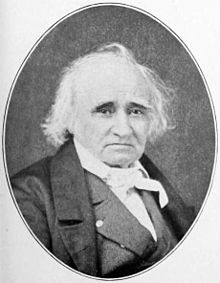Henry Marie Brackenridge
This article includes a list of general references, but it remains largely unverified because it lacks sufficient corresponding inline citations. (January 2011) |
Henry Marie Brackenridge | |
|---|---|
 | |
| Member of the U.S. House of Representatives from Pennsylvania's 22nd district | |
| In office October 13, 1840 – March 3, 1841 | |
| Preceded by | Richard Biddle |
| Succeeded by | William W. Irwin |
| Personal details | |
| Born | May 11, 1786 Pittsburgh, Pennsylvania |
| Died | January 18, 1871 (aged 84) |
| Political party | Whig |
| Signature | |
| Wikimedia Commons has media related to Henry Marie Brackenridge. |
Henry Marie Brackenridge (May 11, 1786 – January 18, 1871) was an American writer, lawyer, judge, superintendent,[1] and U.S. Congressman from Pennsylvania.
Born in Pittsburgh in 1786, he was educated by his father, the writer and judge Hugh Henry Brackenridge, and private tutors before attending a French academy at Ste. Genevieve in what is now Missouri. He studied law and was admitted to the Pennsylvania bar in 1806, then practiced in Somerset, Pennsylvania.
Brackenridge subsequently moved to St. Louis, Missouri, where he was a lawyer and journalist. In 1811, he became the first recorded tourist to present-day South Dakota, hosted by fur trader Manuel Lisa.[2] Henry was appointed deputy attorney general of the Territory of Orleans (Louisiana), and district judge of Louisiana in 1812.
He played an intelligence role during the War of 1812, and in 1814 published a history of the war. In 1817 he was appointed secretary of a mission to South America. He was elected a member of the American Antiquarian Society in 1818.[3] In 1821, Brackenridge entered the diplomatic service of General Andrew Jackson, who was the new commissioner of Florida. Through Jackson's influence, he served as U.S. judge for the western district of Florida from 1821 to 1832.
When President John Quincy Adams established the Naval Live Oak Area on January 18, 1829, Superintendent Brackenridge lived on the property and experimented with cultivating the live oak tree for shipbuilding. He is therefore considered the country's first federal forester.[4]
Brackenridge returned to Pennsylvania in 1832 and became owner of a large tract of land upon which he founded the town of Tarentum, 22 miles northeast of Pittsburgh on the Allegheny River. The adjacent Allegheny County borough of Brackenridge is named for him.
He was elected as a Whig to the 26th United States Congress to fill the vacancy caused by the resignation of Richard Biddle, and served from October 13, 1840, to March 3, 1841. He was an unsuccessful candidate for renomination in 1840.
After politics, Brackenridge pursued literature until his death in Pittsburgh on January 18, 1871. He is buried in Prospect Cemetery in Brackenridge, Pennsylvania.
Brackenridge's published works include Views of Louisiana (1814), part of which was a source for Washington Irving's Astoria, and a pamphlet, South America (1817), which puts forth a policy similar to the Monroe Doctrine. Sent to South America to study political conditions, he recounted his experiences in Voyage to South America (1819). His Recollections of Persons and Places in the West (1834) is considered a valuable historical source.[citation needed]
References[]
- ^ Florida, State Library and Archives of. "Portrait of Henry Marie Brackenridge". Florida Memory. Retrieved April 29, 2016.
- ^ Hogan, Edward Patrick; Fouberg, Erin Hogan (2001). The Geography of South Dakota (Third ed.). Sioux Falls, SD: The Center for Western Studies – Augustana College. ISBN 0-931170-79-6.
- ^ American Antiquarian Society Members Directory
- ^ "The Live Oak Story - Gulf Islands National Seashore (U.S. National Park Service)". www.nps.gov. Retrieved April 29, 2016.
This remainder of this section includes a list of references, related reading or external links, but its sources remain unclear because it lacks inline citations. (July 2020) |
- United States Congress. "Henry Marie Brackenridge (id: B000732)". Biographical Directory of the United States Congress.
- Keller, William F. (1956). The Nation's Advocate: Henry Marie Brackenridge and Young America. Pittsburgh: University of Pittsburgh Press.
- The Political Graveyard
- Members of the United States House of Representatives from Pennsylvania
- 1786 births
- 1871 deaths
- Politicians from Pittsburgh
- Pennsylvania lawyers
- Pennsylvania state court judges
- Pennsylvania Whigs
- Whig Party members of the United States House of Representatives
- People from Pennsylvania in the War of 1812
- Members of the American Antiquarian Society
- 19th-century American politicians
- 19th-century American judges
- 19th-century American lawyers